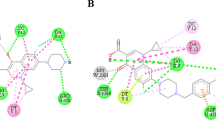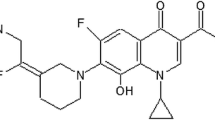Abstract
Structure-activity relationship of 20 fluoroquinolones was studied using the susceptible and 4 resistantEscherichia coli which were developed against 4 fluoroquinolones [ciprofloxacin (1), KR-10755 (6), norfloxacin (2), and ofloxacin (3)] in our laboratory. The C-7 and C-8 substituents of fluoroquinolone were important in various functions such as the inhibitory activity on DNA gyrase, permeability, and efflux. Among 20 fluoroquinolones, compounds with a 3-methyl-3,7-diazabicyclo[3.3.0]octan-1(5)-ene-7-yl substituent at the C-7 position or a chlorine substituent at the C-8 position showed a good inhibitory activity on DNA gyrase (especially a mutated DNA gyrase). Compounds with a 3,7-diazabicyclo [3.3.0]octan-1(5)-ene-7-yl substituent at the C-7 position showed good permeability in the susceptible and resistant strains, while compounds with a fluorine substituent at the C-8 position were less effluxed from cells.
Similar content being viewed by others
References Cited
Chu, D. T. W. and Fernandes, P. B., Structure-activity relationships of the fluoroquinolones.Antimicrob. Agents Chemother., 33, 131–135 (1989).
Coll, R., Gargallo-Viola, D., Tudela, E., Xicota, M. A., Llovera, S. and Guinea, J., Antibacterial activity pharmacokinetics of four new 7-azetidinyl fluoroquinolones.Antimicrob. Agents Chemother., 40, 274–277 (1996).
Gootz, T. D., McGuirk, P. R., Moynihan, M. S. and Haskell, S. L., Placement of alkyl substituents on the C-7 piperazine ring of fluroquinolones: Dramatic differential effects on mammalian topoisomerase II and DNA gyrase.Antimicrob. Agents Chemother., 38, 130–133 (1994).
Heisig, P., Schedletzky, H. and Falkenstein-Paul, H., Mutations in the gyrA gene of a highly fluoroquinolone resistant clincal isolate ofEscherichia coli.Antimicrob. Agents Chemother., 39, 696–701 (1993).
Hirai, K., Aoyama, H., Irikura, T., Iyobe, S. and Mitsuhashi, S., Differences in susceptibility to quinolones of outer membrane mutants ofSalmonella typhimurium andEscherichia coli.Antimicrob. Agents Chemother., 29, 535–538 (1986).
Kim, K., Lee, S. and Lee, Y., Norfloxain resistance mechanism ofE. coli 11 andE. coli 101-clinical isolates ofEschericha coli in Korea.Arch. Pharm. Res., 19, 353–358 (1996).
Kitamura, A., Hoshino, K., Kimura, Y., Hayakawa, I. and Sato, K., Contribution of the C-8 substituent of DU-6859a, a new potent fluoroquinolone, to its activity against DNA gyrase mutants ofPseudomonas aeruginosa.Antimicrob. Agents Chemother., 39, 1467–1471 (1995).
Klopman, G., Fercu, D., Renau, T. E. and Jacobs, M. R., N-1-tert-Butyl-substituted quinolones:in vitro anti-Mycobacterium avium activities and structure-activity relationship studies.Antimicrob. Agents Chemother., 40, 2637–2643 (1996).
Lee, Y., Kim, K., Pyun, H.-E. and Park, W., Characterization of ciprofloxacin, HK3140, norfloxacin, and ofloxacin resistant strains ofEscherichia coli.Korean Biochem. J., 25, 134–140 (1992).
Mitscher, L. A., Devasthale, P. D. and Zavod, R., Structure-activity relationships, In Hooper, D. C., Wolfson, J. S. (Eds.),Quinolone antimicrobial agents, American Society for Microbiology, Washington D. C., pp. 3–52, 1993.
Mitscher, L. A., Zavoid, R. M. and Sharma, P. N., Structure-activity relationships of the newer quinolone antibacterial agents, In Fernandes P. B. (Eds.),Quinolones, J. R. Prous Science Publisher, Barcelona, pp 3–134, 1989.
Pan, X.-S., Ambler, J., Mehta, S. and Fisher, L. M., Involvement of topoisomerase IV and DNA gyrase as ciprofloxacin targets inStreptococcus pneumoniae.Antimicrob. Agents Chemother., 40, 2321–2326 (1996).
Park, S., Lee, S. and Lee, Y., Norfloxacin resistance mechanism ofEscherichia coli 59-a clinical isolate in Korea.Mol. Cells, 6, 469–472 (1996).
Shen, L. L., Mitscher, L. A., Sharma, P. N., O'Donnell, T. J., Chu, D. W. T., Cooper, C. S., Rosen, T. and Pernet, G., Mechanism of inhibition of DNA gyrase by quinolone antibacterials: a cooperative drug-DNA binding model.Biochem., 28, 3886–3894 (1989).
Tillotson, G. S., Quinolones: structure-activity relationships and future predictions.J. Med. Microbiol., 44, 320–324 (1996).
Wentland, M. P., Structure-activity relationships of fluoroquinolones, In Siporin, C., Heifetz, C. L., and Domagala, J. M. (Eds.),The new generation of quinolones. Marcel Decker, Inc., New York, pp. 1–44, 1990.
Wolfson, J. S. and Hooper, D. C., The fluoroquinolones: structures, mechanisms of action and resistance, and spectra of activityin vitro.Antimicrob. Agents Chemother., 28, 581–586 (1985).
Author information
Authors and Affiliations
Rights and permissions
About this article
Cite this article
Lee, S., Park, T. & Lee, Y. Structure-activity relationship of fluoroquinolone inEscherichia coli . Arch. Pharm. Res. 21, 106–112 (1998). https://doi.org/10.1007/BF02974013
Received:
Issue Date:
DOI: https://doi.org/10.1007/BF02974013




